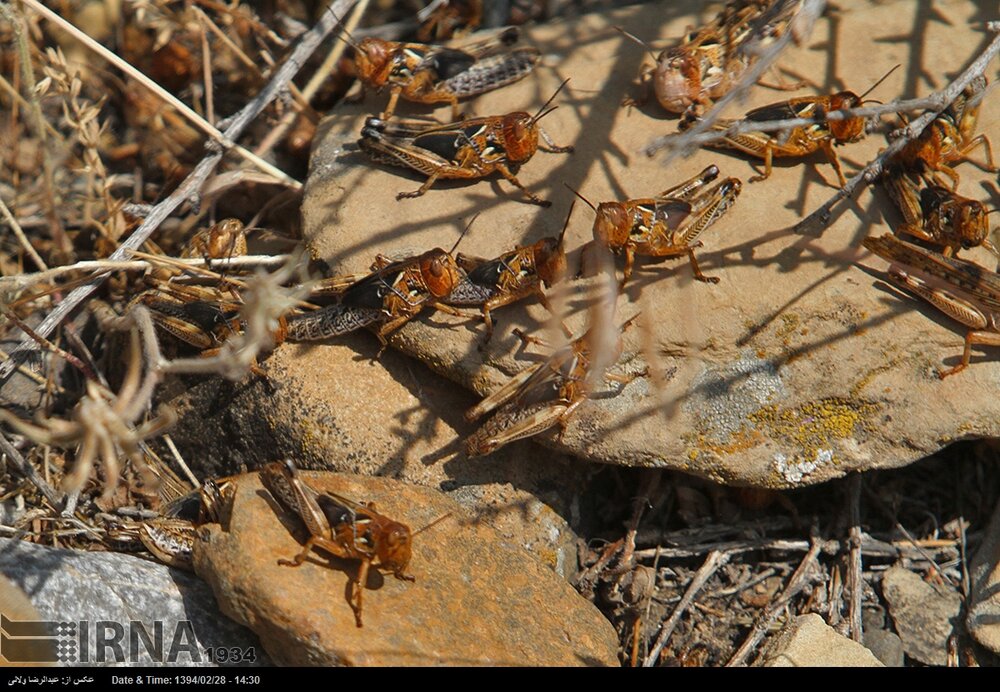Sistan-Baluchestan infested with desert locust

TEHRAN — According to the Food and Agriculture Organization of the United Nations (FAO), the southeastern province of Sistan-Baluchestan is infested by desert locust, director of the agriculture organization of the province has said.
Pest-control chemicals have been applied in approximately 36,700 hectares of plains in 7 cities of the province, IRNA news agency quoted Gholam Heidar Zoraqi as saying on Monday.
Pest-control measures have been taken since early March in the province, Zoraqi said, adding that, the largest pest-control operation was carried out in Konarak.
According to a report updated on May 3, FAO has announced that during the past few weeks, the desert locust situation has intensified in the traditional spring breeding areas of Iran and Saudi Arabia.
In Iran, substantial aerial and ground control operations carried out by national authorities treated more than 86,000 ha during April as breeding continued for a third consecutive month within a large portion of the south, giving rise to groups of hoppers and adults, hopper bands and a few swarms.
The report continues that smaller-scale breeding occurred in adjacent areas of southwest Pakistan and control was undertaken. Breeding will continue in both countries and more hopper bands and a few small swarms are likely to form. There is a moderate risk that adult groups and perhaps a few small swarms will move this year towards the Indo-Pakistan summer breeding areas in about mid-June, depending on control operations and the weather in currently infested areas.
In Saudi Arabia, spring breeding commenced in the interior where hoppers are forming groups and bands. Aerial and ground teams treated more than 27,000 ha during April in the interior as well as on the Red Sea coast where winter breeding has ended.
In Yemen, swarms formed from earlier breeding in the southern Empty Quarter and are moving throughout the interior of the country where survey and control operations were not possible, so locals were catching and eating locusts. Several swarms moved to Najran, Saudi Arabia in the past few days. A few small adult groups moved from eastern Yemen to northern Oman where they laid eggs in April and limited control operations were conducted. Small-scale breeding is expected to continue in Oman. In Yemen, hatching will cause locust numbers to increase significantly in the interior where hopper bands are expected to form.
Elsewhere local breeding occurred in northwest Mauritania where control was undertaken last month. Breeding is underway in eastern Algeria, but the situation is expected to remain calm, the report concluded.
Desert locusts are short-horned grasshoppers that can form large swarms and pose a major threat to agricultural production, livelihoods, food security and the environment and economic development.
FAO explains that adult locust swarms can fly up to 150 km a day with the wind. Female locusts can lay 300 eggs within their lifetime while an adult insect can consume roughly its own weight in fresh food per day - about two grams every day. A very small swarm eats the same amount of food in one day as about 35,000 people and the devastating impact locusts can have on crops poses a major threat to food security, especially in already vulnerable areas.
FAO's Locust Group uses a color-coded scheme; green for “calm,” yellow for “caution,” orange for “threat” and red for “danger”, to keep the world informed of the seriousness of the current locust situation.
FAO has placed Iran, Saudi Arabia, and Sudan in the group of countries where crops face the threat of desert locusts.
Iran Plant Protection Organization director Mohammad Reza Dargahi said on April 17 that the necessary budget for fighting desert locusts is estimated at 100 billion rials (nearly $2.4 million). He highlighted that in case of proper budget allocation the desert locus threat will be eliminated by the end of the [Iranian calendar] month of Tir (July 22).
MQ/MG
Leave a Comment